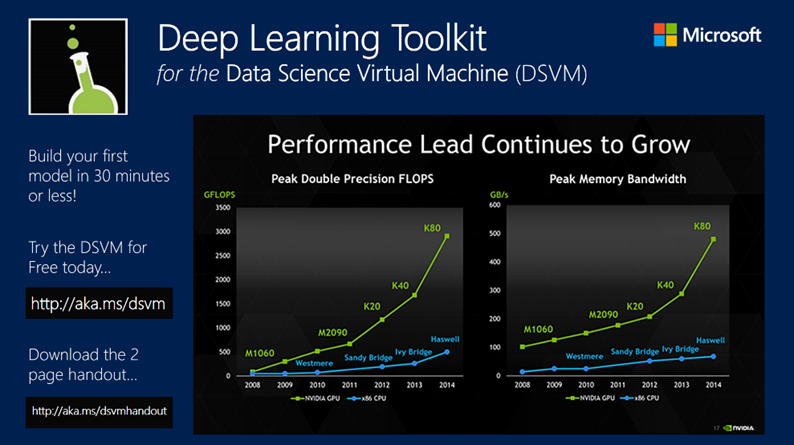Deep Learning Toolkit on the Data Science Virtual Machine
Deep learning is behind many recent breakthroughs in machine learning applications, including language translation with Skype, which was recently named one of the 7 greatest software innovations of the year by Popular Science, and speech recognition, where Microsoft recently achieved human-level parity at conversational speech.

On the 1st of Dec we will be launching our Azure GPU services. These VMs combine powerful hardware (NVIDIA Tesla K80 or M60 GPUs) with discrete device assignment to enable powerful new options for training deep neural networks.
The deep learning toolkit for the DSVM is a solution for the Windows DSVM that installs several GPU-accelerated tools for deep learning, CUDA, cuDNN, the GPU driver and several samples. With the same steps required to create a new VM, you can have a DSVM ready for deep learning on Azure GPUs.
GPU-accelerated deep learning tools available with the VM include mxnet and CNTK, with more on the way.
A few samples are also installed in the C:\dsvm\deep-learning folder, including:
- Character recognition on the MNIST dataset.
- Image classification on the CIFAR-10 dataset.
- Neural artistic style, a way to extract the style of an image and apply it to a new image.
These solutions clearly describe the elements involved in building a deep learning solution and demonstrate the power of the GPUs – use them to explore what’s possible or as a starting point for your own projects.
Resources
Microsoft Machine Learning Team Blog - https://blogs.technet.microsoft.com/machinelearning
Learning Data Science https://mva.microsoft.com
Comments
- Anonymous
January 28, 2017
Major changes are in Jan Update of the DSVM MRS 9.0.1 with new deployment framework (aka DeployR), CNTK v2Beta6 with new notebook samples, RTVS 0.5, Deep learning toolkit for DSVM updates (CNTK2, mxnet, and now TensorFlow), JuliaPro (a curated distribution of Julia Language with libraries for ML, data science, optimization and scientific computing with bunch of notebook samples), Apache Drill access to Azure data sources, RStudio. For more details see https://blogs.technet.microsoft.com/machinelearning/2017/01/27/new-year-new-updates-to-the-windows-data-science-virtual-machine/